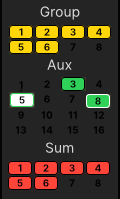mc²36 - Check Bus Assignments

If the bus assignments are not visible, then check the following options in the System Settings display. In both cases, the options affect only what is displayed, and not what is available.
- Bus Routing must be enabled (under "Channel Display → Strip Layout").
- The number of buses displayed can be edited using the "Channel Display → Bay/Main Bus Count" options.
Each indicator represents a mono bus. So, for a 5.1 Sum, you will see all six individual assignments: Sum 1 = L; Sum 2 = R; Sum 3 = C; Sum 4 = LFE; Sum 5 = Ls; Sum 6 = Rs.
The indicators are color-coded as follows: Groups (yellow), Auxes (green) and Sums (red). The Aux indicator colors vary slightly to distinguish the different pickup points for each send: full green = post-fader (e.g. Aux 3); white/green = pre-fader (e.g. Aux 5); green/white = pre-EQ (e.g. Aux 8).
For simplicity at this stage, you should check that all channels are assigned to Sum 1 to 6 (if working in 5.1) or Sum 1 & 2 (if working in stereo). This ensures that once channel panning is turned on, you will benefit from surround, or stereo, panning.
There are several ways to change bus assignments. Below are a couple of methods to get you started. For more information, see mc²36 - Bus Assign.
Bus Assign from the Channel display
- Touch anywhere within the bus assign area to open the "input x" pop-up.
- Note that the same pop-up can be opened by touching any of the following areas: VCA, Mix Minus, Group, Aux, Sum, AMX (Automix) or Signal Present/Source Control.
- Select a page (e.g. Sum Routing).
- Touch the buttons to edit the assignments. You can select a different channel or page without closing the pop-up.
- If the destination is stereo or surround, then the first touch assigns the channel to all components (e.g. to all six Sums). You can then touch again to turn off the individual assignments (e.g. touch Sum 4 to remove the channel from the LFE bus).
- When you have finished editing, touch X at the top right to close the pop-up.
Bus Assign using FADER REVERSE
1. Select the destination channel (e.g. Sum 1/2) - either by pressing its fader SEL button or using the Access/Assign panel.
If you are working in surround, then select the surround VCA master (e.g. SUR S 1).
2. Press FADER REVERSE on the BUS ASSIGNMENT panel:

The BUS ASSIGNMENT buttons can be locked, to protect existing assignments, using the Lock ASN option (on the Extra Buttons display). Therefore, if you cannot make a selection, check the status of this option.
The button starts to flash, and the fader SEL buttons across the console light to show the current status:
- Red (steady state) = assigned.
- Green (flashing) = not assigned.
Not lit = assignment not permitted.

3. Press the fader SEL buttons to edit the assignments.
If the destination is stereo or surround, then the channels are assigned to all of the component channels (L/R, C, LFE, etc). To edit the individual assignments, either put the component channel into access (using the Access/Assign panel) or use one of the forward assign methods.
4. Deselect FADER REVERSE, or press ESC (on the SCREEN CONTROL panel), to exit the bus assign mode.